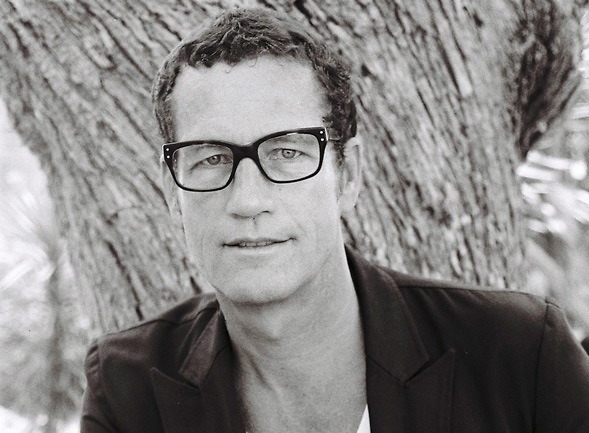Prof. Joachim Sauter is the Head of Design at ART+COM, an interdisciplinary group of designers, architects and artists dedicated to exploring the use of digital technologies and design principles to develop new possibilities. He has been working as a full professor for “New Media Art and Design” at the University of Arts in Berlin since 1991 and also an adjunct professor at UCLA, Los Angeles since 2001. His works in the area of media design and art have earned him exhibitions in international museums and numerous awards such as the ‘Golden Lion, Cannes’, the ‘D&AD Black Pencil’, and the ‘Grand Clio’. The Columnist interviewed him for his opinion on Interactive Design and the way ART+COM contributes to shaping its future.
The Columnist (TC): What is the philosophy that governs the interactive pieces that ART+COM does?
Joachim Sauter (JS): We design interactivity in order to involve people. Very often we are challenged to translate complex content into spatial communication. Interactivity is a very good means to provide multi-layered content that is tailored to people’s individual interests. For us it is important that interactive pieces allow more than one person to explore content at once, so that interaction is not limited by the technology but becomes social in nature. We want people to exchange, to be part of a social experience, to explore and to learn together.
TC: How do you blend cutting-edge technology with the artistic concept in your approach?
JS: From the beginning in 1988, ART+COM has developed a radically interdisciplinary practice. All projects are worked on by our designers and IT-developers in an intense and open dialogue, in which each party steps out of their usual frame of thinking in order to explore new possibilities together. Only when you do this, you are able to invent or establish new principles.
TC: How do you interpret culture and how does it fit into the different art installations that you did all over the world? What were cultural barriers that you encountered during conception of your installations?
JS: We find that the things we do are understood around the globe. This might have different reasons, for example the simple fact that globalisation has created a kind of global knowledge and that new media have become ubiquitous, also in design and art. We see how much our work is perceived and appreciated also outside Europe, particularly in East Asia. This might speak for the fact that our work speaks a ‘global’ language without ignoring the cultural context it is located in. The balance between site-specificity and artistic authenticity is the key for conceiving installations for very different places and situations. “Kinetic Rain” Changi Airport Singapore from ART+COM on Vimeo.
TC: In your opinion, what constitutes good interactive design?
JS: Good interactive design manages to enthral and to engage people. In order to achieve this the design must appeal to human intuition and curiosity. The less you have to explain about the interactivity itself, the better. The lower the threshold to interact, the better. “River is…” and “Salt Worldwide” are good examples of these principles, because visitors understand intuitively how the interaction works. Hence their attention is directed to the pieces’ content and its exploration. But good interactive design has a second quality: it offers much more than just a temporal experience, but has a lasting effect, as it transfers knowledge in a way that it becomes easy to remember. This is achieved through the combination of sensory, often tactile experience and the ‘magic’ that is still inherent in interactivity and generativity.
TC: What is the design process behind the interactive pieces? For example, how did you conceptualise the mirror installation for the “River Is…”?
JS: “River Is…” was commissioned by the Korean Government for the Four Rivers pavilion showing an exhibition about the homonymous eco-restoration project. The installation “River is…” is based on the principle of caustics, the way light refracts on water. We were fascinated by the idea that the ripples of the river could be ‘legible’ and thereby provide information about the processes in the water. We then applied this idea to the design of the installation by creating a computationally designed and 3D-milled surface of 23 square meters and encoded information in its facets. This information – attributes that complete the phrase ‘River Is…’ – can be discovered by using a torch and pointing it to the surface. The light is reflected and cast as words onto the wall. In order to show this principle we added two moving spotlights above the surface that produce these reflections autonomously. River is is a good example for a new kind of interactive piece which does it completely without using the conventional media surface.
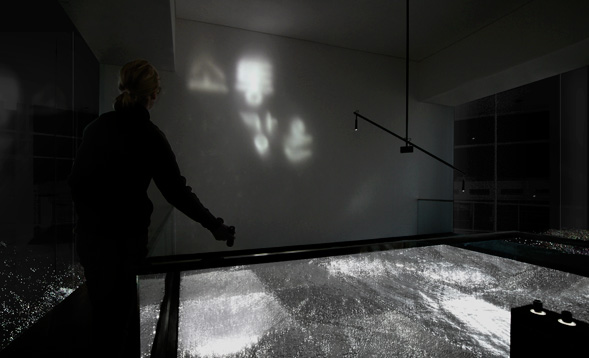
Viewers can discover the sculpture’s hidden meanings with the help of light that is reflected by the wavy mirror forming different words on the wall.
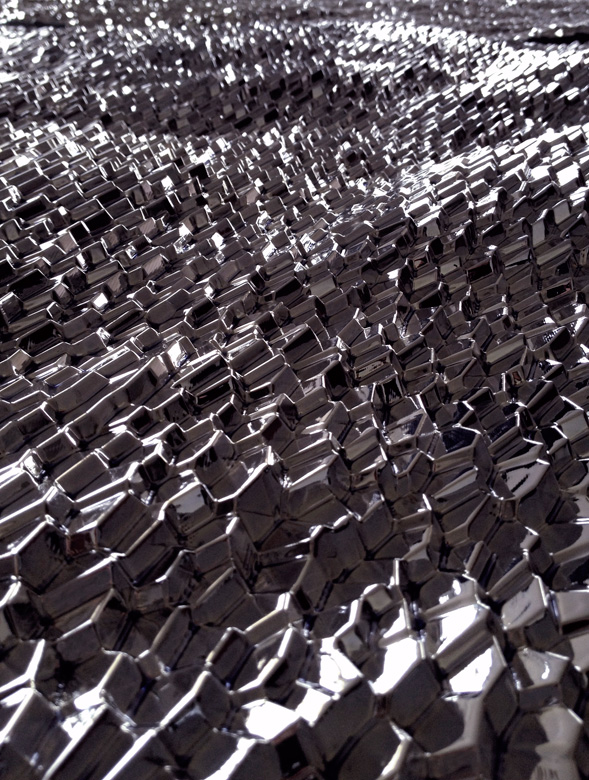
The installations’ wavy chrome-plated surface carries hidden Korean characters encoded in its facets.
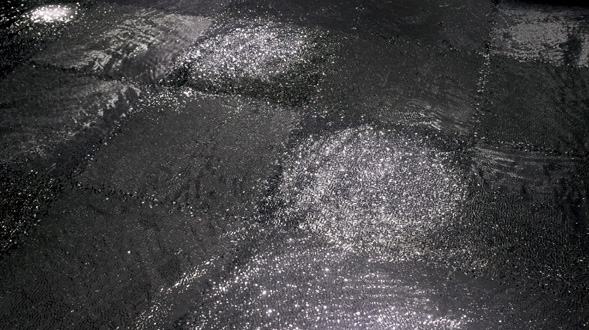
Computationally designed and 3D-milled, the 23 square meters abstract wave sculpture depicts a frozen moment in time of the continuous flowing Yeong San River.
TC: Aside from offering a new approach to learning, is there a deeper meaning behind the “Salt Worldwide” installation and your other projects?
JS: “Salt Worldwide” is an interactive installation at the German Salt Museum in Luneburg and concludes the tour through the museum, a former salt mine.”Salt Worldwide“ tells the story of salt mining around the world. There are 34 touch-sensitive salt crystals spreading over the world map, highlighting the main areas where salt is extracted. According to the amount of salt exploited in these regions, millions of virtual salt particles emit continuously over the world map, slide down along the mountain ridges, then diffuse and flow along the main currents in the seas. When touched the crystals start to glow and release virtual grains of salt that merge into an information window, which displays information about the chosen salt mine in the form of texts, images and movies. This installation serves clearly the purpose of communication of content, however it does this in a poetic and visual way. Algorithmic parameters describe the behavior of the salt flows, so that the installation provides a living and evolving experience that changes over time. Although this is not an art piece with a deeper meaning in the classical sense, the design is not purely functional. Poetry of form is a common quality of all our installations. Salt Worldwide, Luneburg 2010 from ART+COM on Vimeo.
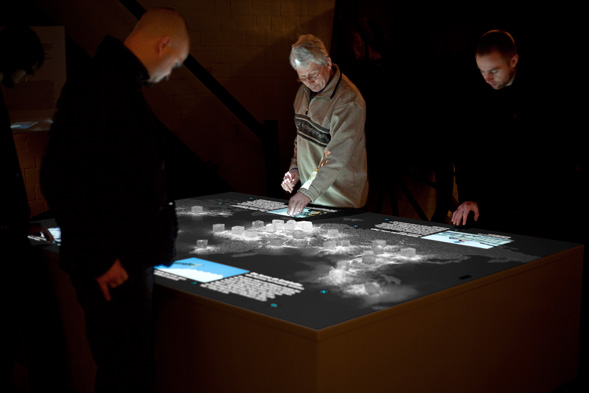
The interactive installation “Salt worldwide” comprises 34 touch sensitive salt crystals spreading over a world map highlighting salt extraction areas.
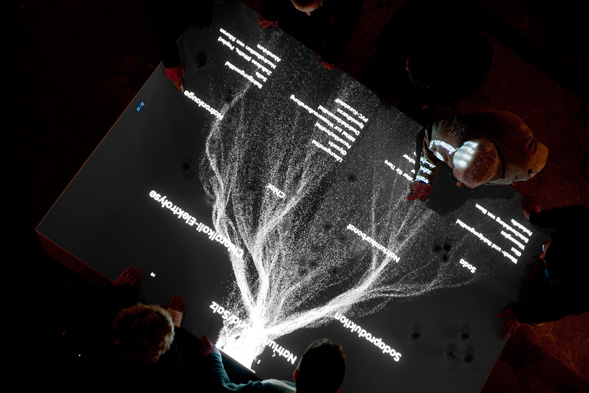
Touching the crystal triggers virtual grains of salt to pour over the installation’s surface and merge into an information window, which displays details of the chosen salt mine through text, images and video.
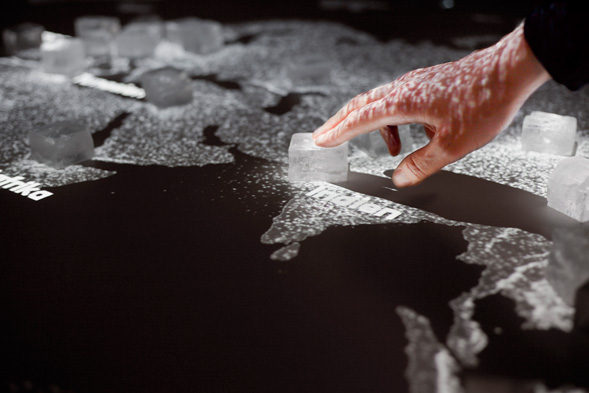
In a 10 minute long guided mode, a tour guide explains the salt production, consumption, usage, and other relevant topics. Each topic is explained by dynamically generated animation.
TC: Where do you see interactive design in the next five years?
JS: Interactive design is pervading all fields. Being widely applied in education and knowledge transfer already, it will affect our social and everyday life even more in the future, because it supports a dialogic process to interact with the world and so matches the contemporary concept of society. We are happy that we can contribute to shaping that future, also in Asia, a region for which we develop a lot of commissioned projects. In comparison, Asia is very open for new design and art concepts which inspires us to expand our thinking.
This interview was conducted for The Columnist, a newsletter by Consulus that offers ideas on business, design and world affairs. The views expressed in this article are those of the interviewee and do not necessarily reflect the views of Consulus.

